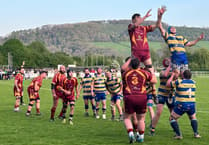So far in this column I have ‘chatted’ about the ethos of functional fitness, the importance of stretching, motivational tips, maintaining good posture and the benefits of post-meal movement and I have had some lovely emails and feedback from readers who are benefitting from this down-to-earth, ‘functional’ approach to better health. Thank you all.
This month I’m going to ‘bang the balance drum’. It’s an important aspect of functional fitness and general well being, as ‘good balance’ will help prevent falls and tumbles – and they’re the things that do the damage!
It always amazes me just how ‘reserved and fearful’ we become as we age, assuming it goes with the territory. It doesn’t have to. Whilst it’s natural to be a bit more cautious and aware of the disadvantages of an injury – it’s not going to be time off school for any of us now – a little caution shouldn’t stop you doing the things you want to.
A friend, Dilys Price, was skydiving well into her 80’s and another friend, Chris Jenkins, raced past retirement ages ago and is still teaching fitness at Usk College, often out-performing students who ‘hit the wall’ before they hit their 20’s.
I am fascinated as to what inspires people to keep as agile and ‘able’ as Ninja’s as they head toward their eighties and nineties. Surely the goal is not to live a long life, but a long and healthy life. It’s not the years in your life that matter but the life in your years.
The definition of balance is ‘an even distribution of weight enabling someone or something to remain upright and steady’ – and therefore avoid falls. Balance training involves doing exercises that strengthen the muscles that help keep you upright, including your legs and core. These kinds of exercises can improve stability and help prevent falls.
The benefits of incorporating balance training into your days include improved body awareness, which according to several studies, decreases the likelihood of injury;
stabilising joints, which can also prevent a large array of injuries including sprained ankles and serious knee problems; improved coordination – essential to avoid stumbling and tripping and quicker reaction times, enabling you to avoid a ‘complete fall’.
Think how you get up from a chair or from the sofa. Do you use your hands to steady or enable you? Do you push off from a table or the arm of a chair? And do you grunt when you do? Trust me, grunting doesn’t improve anything!
Let’s start there – try to get out of a chair without using your hands to help you. A great exercise is actually ‘stand to sit’ – literally how it sounds. Stand up from a chair and sit back down again (unaided) several times.
Another simple exercise is standing on one foot at a time – try to avoid compensating by leaning over heavily on one hip. If you feel unstable, just use the back of a chair or the wall for balance but aim to progress to be able to stand ‘alone’. You can practise this exercise whilst cleaning your teeth or even standing in a queue anywhere – and without raising too many eyebrows. Progressing into ‘tip toe’ on the standing foot will add to the benefits.
I think a good goal is to be able to put your shoes and socks on – obviously lifting one foot at a time–without sitting down or leaning against a wall. I know a few “under-30’s’ who struggle with that.
Sideways walking is also a very useful exercise as it encourages us to move in another ‘plane’, or sideways, which we seldom do naturally. Not surprisingly, most falls are to the side, as we are not used to moving in that direction.
Stand with your feet together, knees slightly bent and step sideways in a slow and controlled manner. Move one foot to the side first and then move the other to join it.
Avoid dropping your hips as you step. Perform 10 steps each way or step from one side of the room to the other. Once comfortable with this move you can progress to a simple grapevine which involves walking sideways by crossing one foot over the other. Start by crossing your right foot over your left and then bring your left foot to join it in a natural stance.
Attempt 5 cross-steps on each side, in front and behind. If necessary, put your fingers against a wall for stability. The smaller your steps, the more you will work on your balance.
Try walking forward ‘heel to toe’ for 20 steps. Steady yourself with a wall if you need a little extra support and walk normally in as straight a line as you can. Stand upright, place your right heel on the floor directly in front of your left toe and then do the same with your left heel. Make sure you keep looking forward at all times. If necessary, put your fingers against a wall for stability. Try to perform at least 5 steps and as you progress, move away from the wall.
One of my favourite ‘tests’ is the sit to stand test, which sounds simple but shocks and frustrates a lot of people. The test requires you to lower yourself to the floor, with legs criss-crossed, without bracing yourself with your hands, knees, arms, or sides of your legs. If you can stand back up, again without the aid of those body parts, you’ve scored a perfect 10 (five points for sitting, five points for standing). You lose a point every time you support yourself with a forbidden joint or appendage.
This “sitting-rising” exercise was designed to predict mortality in middle-aged and older people but is also a good test of core and leg strength as well as balance ability.
You will find this test, plenty more balancing exercises, and step-by-step guides for all ages and stages, online.
And remember–you don’t find balance – you create it.





Comments
This article has no comments yet. Be the first to leave a comment.